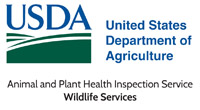United States Department of Agriculture: Animal and Plant Health Inspection Service

United States Department of Agriculture Wildlife Services: Staff Publications
Document Type
Article
Date of this Version
2016
Citation
Industrial Crops and Products 89 (2016) 465–467
Abstract
Winter canola (Brassica napus L.) is considered the most promising domestically-produced oilseed feed-stock for biodiesel production and for diversifying wheat (Triticum aestivum L.)-based cropping systems in the Inland Pacific Northwest, USA. Winter canola field experiments conducted in east-central Washington were completely destroyed, and commercial fields were damaged or destroyed, over several years by large flocks of horned larks (Eremophilia alperestis L.) that ate the cotyledon leaves of pre-emerged and newly-emerged seedlings. Numerous control methods were attempted in field experiments, including laying bird netting over the entire experiment, placement of a life-size predator decoy in a field experiment, loud propane-powered cannon blasts, and mixing garlic with canola seed before planting followed by spraying garlic water on the soil surface. None of the attempted control methods were successful. This is the first report in the literature of horned lark damage to pre-emerged and newly-emerged canola seedlings. We discuss questions relevant to our novel account as well as potential abatement using falcons and non-toxic chemical repellents for the protection of industrial canola crops associated with horned lark depredation.


Comments
U.S. Government Work